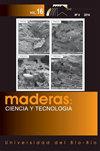锯材生产用大木片的质量
IF 1.5
4区 农林科学
Q2 Agricultural and Biological Sciences
引用次数: 0
摘要
林业公司已经投资于基因改良,以便在更短的时间内增加木材产量。因此,需要对无性系木材和种子木材的特性进行比较研究。本研究的目的是分析克隆源(C1和C2)和种子源(S)的大构造(Tectona grandis)的物理力学特性,并评价经室外和烘箱干燥的锯木的产量和质量。遗传物质是从6棵15岁的树上收集的。无性系C2的树皮量最少,51%的心材可达商品高的一半,而无性系C1和无性系S的心材可达商品高的25%。三种材料在最大角偏差、髓偏心率、基本密度、Janka硬度、各向异性、锯材的商业收益和节的存在方面没有统计学差异。干燥后的种子材料弯曲指数均小于5 mm.m-1,但室外干燥和烘箱干燥后的种子材料开裂率较高。综上所述,三种材料的木材性能相似。另外,建议采用烘箱干燥工艺。本文章由计算机程序翻译,如有差异,请以英文原文为准。
Quality of tectona grandis for sawn wood production
Forestry companies have invested in genetic improvement to increase wood production in a shorter amount of time. Thus, studies are needed to compare the properties of clonal and seminal wood materials. The objective of this study was to analyze physical and mechanical properties of Tectona grandis from clonal (C1 and C2) and seminal (S) origin and evaluate the yield and quality of sawn wood subjected to outdoor and oven drying. Genetic material was collected from six, 15-year-old trees. Clone C2 presented the lowest amount of bark, and 51 % heartwood up to half the commercial height, while the heartwood of C1 and S went up to 25 % of the height. The three materials did not differ statistically for maximum angular deviation, pith eccentricity, basic density, Janka hardness, anisotropy, commercial income of sawn wood and the presence of knots. After the drying processes, the bowing and crooking indexes were less than 5 mm.m-1, however, the seminal material showed a higher cracking incidence after outdoor and oven drying. In conclusion, the wood properties of the three materials are similar. In addition, the oven drying process is recommended.
求助全文
通过发布文献求助,成功后即可免费获取论文全文。
去求助
来源期刊

Maderas-Ciencia Y Tecnologia
MATERIALS SCIENCE, PAPER & WOOD-
CiteScore
2.80
自引率
13.30%
发文量
33
审稿时长
>12 weeks
期刊介绍:
Maderas-Cienc Tecnol publishes inedits and original research articles in Spanish and English. The contributions for their publication should be unpublished and the journal is reserved all the rights of reproduction of the content of the same ones. All the articles are subjected to evaluation to the Publishing Committee or external consultants. At least two reviewers under double blind system. Previous acceptance of the Publishing Committee, summaries of thesis of Magíster and Doctorate are also published, technical opinions, revision of books and reports of congresses, related with the Science and the Technology of the Wood. The journal have not articles processing and submission charges.
 求助内容:
求助内容: 应助结果提醒方式:
应助结果提醒方式:


